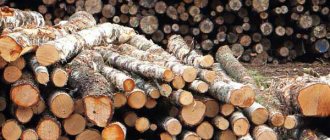What is illegal logging and what is not?
Not everything that is cut down is considered illegal. For example, on your personal plot you can safely remove trees that you don’t need, even without special permission, but with the caveat that the plot should not be adjacent to natural areas that are under state protection.
Trees that cannot be cut down without accompanying documentation include:
- those located along roads and railways;
- that grow in alleys and parks;
- are part of the state forest fund;
- grow on the territory of forest nurseries or agricultural lands.
Moreover, it makes no difference whether these trees were planted by a person or whether they grew on their own.
Tree felling means that the trees have been damaged to the point of complete cessation of their life and growth, but it is considered illegal only when the organizer of the procedure cannot prove the contrary with documentation.
This definition also includes illegally issued and issued permits for logging and those logging that was carried out in violation of deadlines or technologies.
The basis of legal acts that are directly related to this topic are the Forestry and Criminal Codes of the Russian Federation.
Who is involved in the arrest and investigation?
In addition to law enforcement agencies, state forestry inspectors, as well as RosPrirodNadzor, forest rangers, rangers, and forest patrol members are also required to carry out regular raids on their territories.
Complaints and signals from citizens that illegal logging is probably taking place are received by a special Environmental Prosecutor's Office. When a violation is detected at the crime scene, until the circumstances are clarified, all those involved - both customers and performers - are held accountable.
The raid participants draw up a protocol, establish the amount of damage, and if it does not exceed 5 thousand rubles, then the Code of Administrative Offenses of the Russian Federation comes into play.
Victim
As an analysis of criminal cases shows, victims in the investigation of cases of illegal logging are recognized as:
- Employees of departmental forestry services serving the territory in which the tort took place.
- Other owners of land plots where objects of perennial flora have been cut down (representatives of the administration of the relevant municipality, etc.).
The decision on recognition as a victim falls within the competence of investigators and interrogators, who, upon receiving information about the infliction of damage and after presenting the necessary power of attorney, are required to make an appropriate decision.
Punishment and responsibility
For illegal logging, you will be held accountable, which is provided for by administrative and criminal legislation.
Administrative
The cutting down of trees, bushes and other plantings is prosecuted in accordance with the provisions of Article 8.28 of the Code of Administrative Offenses of the Russian Federation, if the act does not contain signs of a criminal offense.
Punishment for violating this article involves the payment of fines. Fines for simple cutting are the following amounts (in thousands of rubles):
- 3-4 - for ordinary citizens;
- 20-40 - for officials;
- 200-300 - for legal entities.
If, during the felling, various mechanisms and equipment were used, or the felling took place in forest-park green belts, then the penalty will be (in thousand rubles):
- 4-5 - for ordinary citizens;
- 40-50 - for officials;
- 300-500 - for organizations.
The presence of such aggravating circumstances as the use of special equipment also implies the confiscation of all logging, and by a court decision both tools and vehicles can be confiscated.
Punishment may also apply to those persons who transport billets, knowing that they were obtained illegally. Thus, even if a person did not directly participate in the logging process itself, the fines will be as follows (in thousands of rubles):
- 5 – for citizens;
- 50 – for officials;
- 400-700 – for legal entities.
Criminal
Any demolition of trees, if permission has not been obtained, is automatically equated to one of the types of environmental crime.
If we talk about criminal matters, then the consideration takes place in accordance with Article 260 of the Criminal Code of the Russian Federation. Moreover, in order to fall under this article, it is not necessary to destroy a forest or part of it—damaged forest cover without the possibility of its subsequent restoration is sufficient. And even if dead wood was cut down, there would be no mitigation of the punishment.
Every person who owns land should know about the existence of such a law. This article provides for several types of punishments, including:
- fine;
- compulsory work;
- correctional work;
- deprivation of the right to engage in a certain type of activity (up to 3 years);
- imprisonment (for up to 4 years with a fine of 300-500 thousand rubles).
The classification of the scale of the offense is divided into 3 groups - significant, large and especially large. Each class has its own fine:
- with significant – from 5 thousand to 49,999 rubles;
- for a large size – 50,000-149,999 rubles;
- for a particularly large size – from 150,000.
Forest groups
All forests on the territory of Russia can be classified into 3 groups according to their environmental and economic importance:
- This group includes plantings that have a water protection and protective function. For example, these could be forest belts along the banks of reservoirs or wooded areas on mountain slopes. This group also includes forests that perform sanitary, hygienic and health-improving functions, national reserves and parks, and natural monuments. The forests of the first group account for 17% of the total forest area.
- The second group includes plantings in areas with high population density and a well-developed transport network. This also includes forests with an insufficient timber resource base. The second group accounts for about 7%.
- The largest group accounts for 75% of its share in the forest fund. This category includes plantings for operational purposes. Due to them, the needs for wood are met.
The division of forests into groups is described in more detail in the “Fundamentals of Forest Legislation”.
When can liability be avoided?
Laws regarding deforestation are very weak and have many weaknesses.
For example, a single designation for the term “felling” has not yet appeared. In addition, in a number of regions the interpretation of the law itself differs - some believe that only direct logging is criminally prohibited, and specific participants can be considered guilty, and those who are engaged in related activities are just accomplices. In a number of other regions, on the contrary, all identified persons are considered violators, regardless of what role they played in the process.
It is precisely because of such disagreements in the law that lawyers have a lot of room for maneuver. This practice clearly demonstrates that it is extremely difficult to actually record and then prove a violation, and sometimes it is not at all possible.
For example, timber is not always removed on the same day on which the felling was carried out. In such cases, detainees may claim that they did not cut anything out, but were simply removing abandoned trees.
Both small loggers and gray industrialists take advantage of such imperfections in the system, which is why the scale of illegal logging continues to increase every year.
Obtaining permission to cut down
If you intend to cut down or replant trees, you must obtain a so-called “cutting ticket,” which is a permit to carry out the procedure. You can contact him in the following cases:
- during the reconstruction of capital construction projects;
- when carrying out major and current repairs of utilities;
- during demolition of buildings and structures;
- when restoring the standard light regime in residential and non-residential premises;
- when conducting engineering-geological surveys.
Individuals, legal entities, individual entrepreneurs, as well as those authorized to carry out construction can receive a ticket. To obtain a logging permit, the following documents are required:
- statement;
- passport or any other document that identifies the applicant;
- dendroplane;
- a document that identifies the applicant's representative;
- a document that confirms the authority of the representative;
- statement of account.
The legislative framework
Depending on the situation and circumstances of the offense, the guilty party may be held liable in various ways, according to the articles:
- Art. 8.28 of the Code of Administrative Offenses of the Russian Federation - illegal logging, unauthorized digging up of trees, bushes, vines in forests or damage to forest plantations;
- Art. 260 of the Criminal Code of the Russian Federation – illegal logging of forest plantations;
- Art. 8.29 Code of Administrative Offenses of the Russian Federation – destruction of animal habitats;
- Art. 16 LC RF – felling of forest plantations;
- Art. 13 LC RF – forest infrastructure;
- Art. 14 LC RF – timber processing infrastructure;
- Art. 21 LC RF – construction, reconstruction and operation of facilities that are not related to the creation of forest infrastructure;
- Art. 29 LK RF – timber harvesting.
We examined one of the types of poaching that is currently flourishing. In pursuit of money, people do not understand what serious harm is caused to nature, the environment and us, and illegal deforestation is a common phenomenon today.
Article 260. Illegal logging of forest plantations
Commentary on Article 260
1. The direct object of the crime is social relations for the protection and rational use of forest plantations or trees, shrubs and vines not classified as forest plantations. Relations regarding the use and protection of forests and other plantings are regulated by the Law on Environmental Protection, the LC, legal acts of the Government of the Russian Federation, constituent entities of the Russian Federation and local governments adopted within their competence, as well as civil and land legislation. In accordance with Art. 5 LC the forest is considered as an ecological system and as a natural resource. Based on the environmental, economic, ecological and social significance of forests located on forest fund lands, they are divided according to their intended purpose into protective, operational, and reserve (Article 10 of the LC). Forests located on lands of other categories can be classified as protective. Features of the protection, use, reproduction of forests of these categories and the content of forest categories are set out in Art. Art. 102 - 109 LC. Forests are located on forest lands that are federally owned (Article 3 of Federal Law No. 201-FZ of December 4, 2006 “On the entry into force of the Forest Code of the Russian Federation”) and lands of other categories. The latter should include lands of transport, populated areas (settlements), lands of the water fund, etc. The boundaries of lands of the forest fund and lands of other categories on which forests are located are determined in accordance with forestry, land legislation and legislation on urban planning activities. 2. The subject of the crime is forest plantings, i.e. trees, shrubs and vines growing in forests, as well as the specified plantings growing outside forests (for example, plantings in parks, alleys, trees separately planted within the city, plantings in the right of way of railways and highways or canals). In this case, it does not matter whether forest plantations or trees, shrubs, and vines not classified as forest plantations were planted by man or whether they grew without his targeted efforts. Thus, felling of protective and green plantings not included in the state forest fund on lands of defense, transport, water resources and lands of other categories is classified as illegal cutting of forest plantations. Since the commented article establishes liability for the illegal logging of trees, shrubs and lianas that are in their natural state, which have grown on their own, as well as for the illegal logging of trees, shrubs and lianas planted by humans to replenish forest and non-forest plant funds, it should be bearing in mind that the term “plantings”, “migrated” to the Criminal Code from forestry legislation, is not entirely correct. In particular, trees, shrubs and vines growing on agricultural lands (with the exception of forest plantations intended to protect lands from the effects of negative (harmful) natural, anthropogenic and man-made phenomena), on personal plots of land do not fall within the scope of these crimes. , on land plots provided for individual housing, garage construction, personal subsidiary and dacha farming, gardening, livestock and vegetable gardening, in tree nurseries, nurseries of fruit, berries, ornamental and other crops. In these cases, trees and shrubs are commercial products, harvested for sale and perform an economic rather than an environmental function. Windfall, windbreak, and dead trees are also not included in the subject of the crime under consideration, unless otherwise provided by special regulatory legal acts. Felling of the listed plantings, as well as their destruction or damage, if there are grounds for this provided by law, can be qualified as theft or destruction or damage to someone else's property. Taking possession of trees cut down and prepared for storage, sale or export by other persons should also be qualified as theft of someone else's property (clause 21 of the Post. Plenum of the Armed Forces of the Russian Federation dated October 18, 2012 N 21). 3. From the objective side the crime consists of illegal logging , as well as damage to the point of stopping the growth of forest plantations and trees , shrubs , vines that are not classified as such . Plenum of the Armed Forces of the Russian Federation in paragraph 16 of the Post. dated 10/18/2012 N 21 indicated that “the felling of forest plantations or trees, shrubs and vines not classified as forest plantations in relation to Article 260 of the Criminal Code should be understood as their cutting, felling or cutting, i.e. separating in various ways a tree trunk, a bush stem and a vine from the root.” The Forest Code the felling of forest plantations as “the processes of cutting them down, cutting them down” (Article 16). However, the meaning of the comment. article, in our opinion, cutting should also be considered any other method of separating a tree, bush, vine from the ground (uprooting, weeding, pulling out, digging with a clod of earth, which has become widespread in recent years, and other methods of separating a plant from the ground or from the roots) . Digging, in particular, is mentioned along with logging in the Taxes mentioned below for calculating damage caused to forests due to violation of forest legislation. Types of felling and types of plantings allowed for felling are determined by Art. Art. 16, 17 LC. The procedure for felling forest plantations is determined by the rules of timber harvesting, the rules of sanitary and fire safety in forests, and the rules of forest care (Part 2 of Article 16 of the Leningrad Code). The use of forests, which constitutes entrepreneurial activity, is carried out on forest lands by persons registered in the Russian Federation in accordance with Federal Law dated 08.08.2001 N 129-FZ “On state registration of legal entities and individual entrepreneurs” - Part 3 of Art. 25 LC. The types of forests in which entrepreneurial activity is allowed and the total volumes of wood allowed for felling are established by Art. 29 LC. The list of species of trees and shrubs, the harvesting of which is not permitted, is established by the federal executive body authorized by the Government of the Russian Federation <1>. ——————————— <1> See: Order of Rosleskhoz dated December 5, 2011 N 513 “On approval of the List of species (species) of trees and shrubs, the harvesting of which is not allowed.”
Legal entities and citizens can harvest wood on the basis of lease agreements for forest plots, and in the case of logging without the provision of forest plots - on the basis of purchase and sale agreements for forest plantations. The procedure for providing forest plots for use to citizens and legal entities is determined by Art. Art. 71 - 80 LC. Wood harvesting by citizens for heating, construction and other personal needs is carried out on the basis of contracts for the sale and purchase of forest plantations (Article 30 of the Labor Code). The procedure and standards for such procurement are established by the laws of the constituent entities of the Russian Federation. At the same time, the Plenum of the Armed Forces of the Russian Federation in paragraph 16 of the Post. dated 10/18/2012 N 21 draws the attention of the courts to the fact that a lease agreement for a forest plot or a decision to provide a forest plot with other rights for timber harvesting or other types of forest use are not sufficient legal grounds for logging of forest plantations. Thus, felling of forest plantations by a tenant of a forest plot is considered illegal even in cases where such a person does not have documents for cutting forest plantings on the leased plot (for example, a forest development project that has received a positive conclusion from a state or municipal examination) or trees have been cut down, felling which were not intended by the forest development project or were carried out in violation of the deadlines. In general, felling of plantings not carried out in accordance with the stated requirements is illegal, including felling carried out even if there is a permit, but in violation of the conditions specified in it: not in the designated area (cutting area), not in quantity, different tree species or wrong age composition as indicated in the document, before or after the dates specified in it, trees, shrubs and vines prohibited from felling, or after a decision has been made to suspend, limit or terminate the activities of the forest user or the right use of a forest fund site, etc. Damage to the point of stopping the growth of forest plantations or non-forest trees, shrubs and vines includes damage that irreversibly impairs the ability of the plantings to continue growth (for example, breaking a tree trunk, stripping the crown, peeling bark). completed from the moment of cutting down forest plantations and trees, shrubs and vines not classified as such, or from the moment they are damaged to the point of stopping growth, if these acts are committed in a significant amount (5,000 rubles). From the notes to comment The article follows that the size of the felling is identified with the damage caused to forest plantations and trees, shrubs and vines not classified as such, and therefore the corpus delicti is material . a causal relationship between the logging and the resulting consequences . When determining the size of felling or damage, it should be kept in mind that Post. Government of the Russian Federation dated 05/08/2007 N 273 “On calculating the amount of damage caused to forests due to violation of forest legislation” approved. relevant rates and methods: - Rates for calculating the amount of damage caused to forest plantations or trees, shrubs and vines not classified as forest plantations due to violation of forestry legislation, the harvesting of which is permitted (Appendix No. 1); — Taxes for calculating the amount of damage caused to trees and shrubs, the logging of which is not allowed (Appendix No. 2); — Methodology for calculating the amount of damage caused to forests, including forest plantations, or trees, shrubs and vines not classified as forest plantations due to violation of forest legislation (Appendix No. 3); — Taxes for calculating the amount of damage caused to forests as a result of violation of forest legislation, with the exception of damage caused to forest plantations or trees, shrubs and vines not classified as forest plantations (Appendix No. 4). When calculating damage caused by illegal logging or damage to trees and shrubs, the harvesting of which is not permitted , one should now be guided only by centrally approved regulations. Taxes, without taking into account regional norms, since in Appendix No. 2 of the said Resolution they are set out in relation to each subject of the Russian Federation. We believe that when determining the size of illegal logging, as well as when determining damage due to illegal harvesting of aquatic animals and plants and illegal hunting, one should take into account not only economic damage, but also environmental damage <1>. ——————————— <1> See: Zhevlakov E.N. On calculating the amount of damage caused by illegal cutting of trees and bushes // Legality. 2002. N 10.
4. From the subjective side, the crime in question is committed with direct intent . The motives for the crime do not matter for qualification. 5. The subject of the crime is a sane individual who has reached the age of 16. 6. Qualifying features in part 2 of the comment. articles: - group of persons (clause “a”) (see commentary to Article 35 of the Criminal Code); - a person using his official position (clause “c”). These can be both officials of state institutions, organizations (forestry enterprises, forestry management bodies, forest protection bodies, etc.), as well as managers or other persons performing management functions in economic entities of other forms of ownership and their structural divisions, carrying out using forest resources or performing any work (see note to Article 201 of the Criminal Code). Criminal liability under points “a” and “c” of Part 2 of Art. 260 of the Criminal Code occurs regardless of whether illegal felling of forest plantations or non-forest trees, shrubs and vines has been committed in a significant amount (clause 18 of the Post. Plenum of the Armed Forces of the Russian Federation of October 18, 2012 N 21); - large size (item “g”) (50 thousand rubles). Officials or persons performing managerial functions in non-governmental organizations, on whose orders illegal cutting of forest plantations is carried out during logging, as well as when laying routes for pipelines, power lines, geological exploration, construction and other work, if there are signs of a crime, are liable only for part 2 comments articles. Qualifications according to Art. Art. 201 and 285 of the Criminal Code in their entirety are not required. 7. In part 3 comments. The article provides for special qualifying criteria : - especially large size (150 thousand rubles); - a group of persons by prior conspiracy or an organized group (see commentary to Art. 35, 258). 8. The actions of a person who has committed illegal cutting of plantings and then disposed of the wood at his own discretion do not require additional qualification under the articles of the Special Part of the Criminal Code on liability for theft of someone else’s property (clause 21 of the Post. Plenum of the Armed Forces of the Russian Federation of October 18, 2012 N 21). The acquisition, storage, transportation, processing for marketing purposes or sale of knowingly illegally harvested wood, committed in a large (over 50 thousand rubles) or especially large (over 150 thousand rubles) amount, is qualified under Art. 191.1 CC. It seems that the acquisition of obviously illegally extracted wood in any amount without the purpose of selling it for one’s own needs or its sale , but in an amount less than specified in Art. 191.1 of the Criminal Code, should be qualified under Art. 175 of the Criminal Code. In this case, the wood acquired the character of property, and the actions with it specified in Art. Art. 175, 291.1 of the Criminal Code, form crimes in the sphere of economic activity. 9. Illegal logging of forest plantations should be distinguished from administrative offenses provided for in Art. Art. 8.25, 8.28, 11.21 Code of Administrative Offences. The difference between the offenses provided for in Art. 8.25 Code of Administrative Offenses, and comment. article of the crime is that the types of forest management provided for in it, including logging, are carried out on the basis of legally obtained permits, but in violation of the conditions specified in them. Thus, felling of forest plantations by tenants of forest plots who have a forest development project that has received a positive conclusion from a state or municipal examination, in violation of wood harvesting technology, including felling without submitting a report on the use of forests, is subject to qualification under Art. 8.25 Code of Administrative Offences. Article 260 of the Criminal Code provides for illegal logging of forests and other plantings in the presence of the compositional characteristics specified in it. Article 8.28 of the Code of Administrative Offenses is applied if the acts specified therein do not contain elements of a crime: significant size, by a group of persons, etc. Explanation of the Plenum of the RF Armed Forces in paragraph 22 of the Post. dated 10/18/2012 N 21, which is the criterion for delimiting the crime provided for in Art. 260 of the Criminal Code, from an administrative offense (Article 8.28 of the Administrative Code) is the degree of damage to forest plantations, does not take into account the amount of damage that must be caused (in the amount of more than 5 thousand rubles). The offenses specified in Art. 11.21 of the Code of Administrative Offences, differ from those discussed above in the place of their commission (road right-of-way and roadside strips), and from criminal illegal logging (Article 260 of the Criminal Code) - in terms of composition (size, group of persons, use of official position, etc.).









